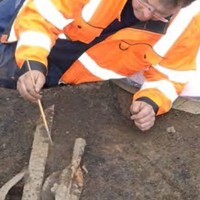- Born 1968, MA - archaeology at University of Bergen 1996, Archaeologist / senior adviser at Hordaland County Council 1998 -edit
The article is based on an archaeological rescue digging of a burial ground on the island of Tysnes. The burial ground has had many burial mounds and fences that have been removed a little after a while. The archaeological investigations... more
The article is based on an archaeological rescue digging of a burial ground on the island of Tysnes. The burial ground has had many burial mounds and fences that have been removed a little after a while. The archaeological investigations revealed finds of ancient iron age and bronze age.
Artikkelen er basert på en arkeologisk rednings graving av et gravfelt på øyen Tysnes. Gravfeltet har hatt mange gravhøyer og røyser som litt etter litt har blitt fjernet. De arkeologiske undersøkinger gav funn av gravlegginger fra eldre jernalder og bronsealder.
Artikkelen er basert på en arkeologisk rednings graving av et gravfelt på øyen Tysnes. Gravfeltet har hatt mange gravhøyer og røyser som litt etter litt har blitt fjernet. De arkeologiske undersøkinger gav funn av gravlegginger fra eldre jernalder og bronsealder.
Research Interests:
This article deals with building remains dating from the Middle Ages. It is found in the village of Ulvik in Hardanger. Right up to the end of the 19th century, a cellar from the Middle Ages was standing. This has been interpreted as both... more
This article deals with building remains dating from the Middle Ages. It is found in the village of Ulvik in Hardanger. Right up to the end of the 19th century, a cellar from the Middle Ages was standing. This has been interpreted as both a hospice and a women's convent, but has probably been a representative residence for the knights living on the farm.
Research Interests:
Two metal detector finds from the village of Kvam in Hordaland county, which proved to be burial ground from the Iron Age. One from the early Merovingian period and one from the early Viking era.
Research Interests:
Research Interests:
This paper discusses how the system of beacons at the coast of Norway may have worked when established by the viking king Håkon Adelsteinsfostre in the years after 954 AD. Starting with the coastal beacon at the mountain " Siggjo" in... more
This paper discusses how the system of beacons at the coast of Norway may have worked when established by the viking king Håkon Adelsteinsfostre in the years after 954 AD. Starting with the coastal beacon at the mountain " Siggjo" in Hordaland county and innwards the Hardangerfjord. I try to identify which beacons are real and which one is missing for the system to work out for mobilize the Norwegian naval fleet "Leidang"
The article discusses the Anglo Saxon Swords of the Viking Age found in Norway. By placing these into a Norse context, one can see the outlines of an Anglo Saxon Sword typology and chronology back on the British eyes. The British swords... more
The article discusses the Anglo Saxon Swords of the Viking Age found in Norway. By placing these into a Norse context, one can see the outlines of an Anglo Saxon Sword typology and chronology back on the British eyes. The British swords also show a religious conflict in the Norse society, when many of the swords are ritually destroyed and de-Christianized when they have been placed in the Norwegians graves.
